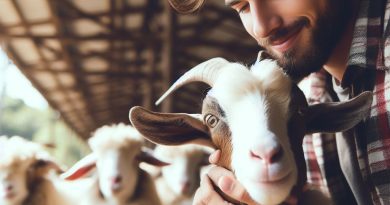Beekeeping Health: Hive Disease Prevention
Last Updated on January 21, 2024
Introduction
Importance of beekeeping health
Let’s Explore Beekeeping Health: Hive Disease Prevention
Beekeeping health is crucial for the well-being of hives and the production of honey.
Protecting the health of bees ensures their productivity and helps maintain biodiversity.
Overview of hive diseases
Hive diseases, such as American foulbrood and chalkbrood, can significantly impact bee colonies.
These diseases can weaken or destroy hives, resulting in the loss of bees and honey production.
American foulbrood is a highly contagious bacterial disease that affects the larvae of bees.
It spreads quickly and can ultimately kill an entire colony if not detected and treated promptly.
Chalkbrood, on the other hand, is a fungal disease that affects both the larvae and adult bees.
It causes mummification of infected bees and weakens the overall strength of the hive.
Preventing hive diseases is crucial to the success of beekeeping operations and the health of colonies.
Regular inspections and monitoring of hives are essential in identifying and treating diseases early on.
Practicing good hygiene, such as cleaning hive equipment and using clean beekeeping tools, can help prevent infections.
References to specific guidelines on disease prevention should be consulted and followed for successful beekeeping.
Therefore, maintaining beekeeping health is crucial to ensuring the well-being of hives and the production of honey.
Common Hive Diseases
Hive disease prevention is crucial for the health and survival of bee colonies.
Understanding the common hive diseases, their causes, symptoms, prevention methods, and treatment options is essential for beekeepers to maintain healthy hives.
American foulbrood
One of the most serious hive diseases is American foulbrood, caused by the bacterium Paenibacillus larvae.
It primarily affects the brood, with symptoms including larvae turning dark and becoming rope-like, emitting a foul odor.
To prevent its spread, beekeepers should practice good hygiene, such as regularly cleaning and sterilizing equipment.
Treatment options for American foulbrood include antibiotics such as oxytetracycline or tylosin.
European foulbrood
European foulbrood, caused by the bacterium Melissococcus plutonius, affects larvae and pupae.
Infected larvae become discolored and twisted, often dying before sealing their cells.
Regular colony inspections and hygienic practices can prevent the spread of European foulbrood.
Treatment options include antibiotics like oxytetracycline and terramycin.
Nosema disease
Nosema disease is caused by microscopic parasites, Nosema apis and Nosema ceranae.
Infected bees suffer from dysentery, weakened immune systems, and shortened lifespans.
To prevent Nosema disease, beekeepers should ensure bees have access to good nutrition, reduce stress, and provide clean water sources.
Treatment options include formic acid, fumagillin, and alternative treatments like thymol or essential oils.
Varroosis
Varroosis, caused by the parasitic mite Varroa destructor, affects both adult bees and brood.
Symptoms include deformed wings, weakened bees, and increased susceptibility to viral infections.
Integrated pest management techniques and controlling mite populations are essential for preventing varroosis.
Treatment options include organic acids, essential oils, and synthetic chemical acaricides.
Most importantly, beekeepers must remain vigilant in monitoring and preventing common hive diseases.
By understanding the causes, symptoms, prevention methods, and treatment options for diseases like American foulbrood, European foulbrood, Nosema disease, and varroosis, beekeepers can promote the overall health and well-being of their bee colonies.
Regular maintenance, hygiene practices, and appropriate treatment when necessary will help maintain thriving and productive hives.
Read: Llama & Alpaca: Preventive Health Tips
Best Practices for Hive Disease Prevention
Regular inspections
Regular inspections are key to preventing hive diseases.
By inspecting your hives frequently, you can identify any signs of diseases early on and take necessary actions to prevent their spread.
Make sure to gather all the required equipment, including a bee suit, smoker, gloves, and hive tool, before conducting inspections.
During inspections, be vigilant for any unusual odors, dead bees, or abnormal brood patterns.
These can be indicators of disease presence.
By actively looking for these signs, you can intervene in a timely manner and minimize the impact of diseases on your colony.
Hygienic practices
Maintaining hygienic practices is crucial for hive disease prevention.
Regularly cleaning and sterilizing your tools and equipment is essential to avoid cross-contamination.
Cleanliness is also important for beekeepers themselves.
Before handling the hives, ensure that you wash your hands thoroughly to reduce the risk of introducing any pathogens.
Proper disposal of infected materials is another aspect of hygienic practices.
When removing any contaminated or diseased material from the hive, make sure to dispose of it properly.
This will prevent the spread of diseases to healthy colonies.
Genetic selection
Genetic selection plays a significant role in hive disease prevention.
Breeding disease-resistant bees can greatly improve hive health and reduce susceptibility to diseases.
By selecting bees with innate resistance to common diseases, you can establish a stronger and more resilient apiary.
Obtaining queen bees from reputable sources known for their disease-resistant genetics is essential.
Reputable breeders prioritize the health and genetics of their bees, ensuring you receive high-quality and resistant queens for your hives.
To promote overall hive resilience, it is important to maintain diversity in bee genetics.
Monoculture can increase the vulnerability of hives to certain diseases.
By introducing genetic diversity through responsible breeding practices, you enhance the ability of your bees to combat different pathogens and pests.
Hive management
Proper hive management practices contribute significantly to disease prevention.
Ensuring proper ventilation within the hives helps prevent the buildup of moisture and humidity, which can create a favorable environment for disease development.
Monitor and control the temperature within the hive to provide optimal conditions for your bees to thrive and maintain their health.
Avoid overcrowding of bees, as it can lead to stress and increased disease susceptibility.
Adequate space allows bees to move freely, reducing the likelihood of diseases spreading rapidly within the colony.
Regularly assess the population and manage hive congestion accordingly.
By implementing these best practices, you can significantly reduce the risk of hive diseases and promote overall hive health.
Regular inspections, hygienic practices, genetic selection, and proper hive management all contribute to disease prevention and the well-being of your bees.
Read: Rabbit Care: Preventing Common Ailments

Early Detection and Diagnosis
Importance of early detection
- Early detection is crucial in preventing the spread of diseases within bee colonies.
- Identifying and addressing health issues at an early stage can save the entire hive.
- Prompt detection allows for swift intervention and implementation of effective treatment measures.
- Early intervention helps preserve the overall health and productivity of the beekeeping operation.
- By detecting diseases early, beekeepers can prevent the loss of valuable honeybee colonies.
Signs and symptoms to watch for
- Abnormal behavior, such as increased aggression or disorientation, can indicate underlying health problems.
- Unusual mortality rates among individual bees or within the colony can be a sign of disease.
- Presence of dead bees outside the hive or on the bottom board may suggest health issues.
- Changes in brood patterns, including irregular or spotty brood, could indicate disease or infestation.
- An offensive odor emanating from the hive can be a strong indication of a diseased hive.
Utilizing diagnostic tools and techniques
- Regular inspections and monitoring are essential for effective disease detection.
- Utilize magnifying glasses or microscopes to examine individual bees for signs of disease or parasites.
- Perform routine tests, such as sugar shakes or alcohol washes, to check for varroa mite infestations.
- Collect and analyze samples of bees, comb, or hive debris for further examination.
- Stay updated on advancements in diagnostic tools and research to enhance disease identification.
Seeking professional help
- If unsure about the health of your hive, do not hesitate to seek assistance from experienced beekeeping professionals.
- Contact local beekeeping associations or cooperative extension offices for expert guidance.
- Professional beekeepers can provide accurate diagnoses and recommend appropriate treatment plans.
- Working with professionals ensures timely and effective interventions to promote hive health.
- Seeking professional help is crucial when facing unfamiliar symptoms or emerging diseases.
Early detection and diagnosis play a pivotal role in preventing and managing hive diseases.
Beekeepers must remain vigilant, observing the signs and symptoms of potential health issues within their colonies.
Timely intervention not only safeguards the well-being of individual hives but also helps in preserving the overall vitality of the entire beekeeping operation.
Read: Breeding Tech: New Trends in Livestock Genetics
Treatment Options for Hive Diseases
Hive diseases can wreak havoc on bee colonies if left untreated, potentially leading to their demise.
Fortunately, beekeepers have several treatment options at their disposal to combat these diseases.
This section will explore the various treatment methods available, including chemical and organic treatments, IPM approaches, and seeking guidance from experienced beekeepers and veterinarians.
Chemical treatments
Chemical treatments involve the use of medications, pesticides, or miticides to combat hive diseases.
These treatments are typically synthetic in nature and can effectively eliminate harmful pathogens and pests.
- Medications such as antibiotics can be administered by beekeepers to treat bacterial infections, such as American foulbrood (AFB) or European foulbrood (EFB).
- Pesticides are often used to control mites, such as Varroa destructor, which can weaken and kill honeybee colonies if left unchecked.
- Miticides specifically target mites and are commonly used in integrated pest management strategies to reduce mite populations.
Organic treatments
For beekeepers who prefer a more natural approach, organic treatments offer effective alternatives without the use of synthetic chemicals.
These treatments are considered safer for bees and the environment.
- Essential oils, such as thymol or lemongrass oil, can be used to control mite populations. These oils are applied in specific forms, such as vaporizing or using strips, to minimize harm to bees.
- Organic acids, such as formic acid or oxalic acid, are commonly used to treat hives infected with Varroa mites. These acids are naturally found in honey and pose minimal risk to bees when used correctly.
Integrated Pest Management (IPM) approaches
Integrated Pest Management is a comprehensive approach that combines different strategies to manage pests and diseases in bee colonies.
- Monitoring: Regular hive inspections and early detection of diseases and pests help beekeepers intervene before problems escalate.
- Cultural practices: Practices like using resistant bee breeds, proper sanitation, and maintenance of optimal hive conditions help create an inhospitable environment for pests and diseases.
- Biological controls: Beneficial organisms, such as predatory mites or bacteria, can be introduced to control pests without harming the bees.
Consultation with experienced beekeepers and veterinarians
When facing complex hive diseases or unfamiliar situations, seeking advice from experienced beekeepers or veterinarians is highly valuable.
- Beekeepers with years of experience can provide insights and guidance based on their firsthand knowledge of managing hive diseases.
- Veterinarians specializing in bees possess medical expertise and can provide professional recommendations for disease treatment.
Overall, beekeepers must be proactive in preventing and treating hive diseases.
Combining appropriate treatment options with good hive management practices is crucial for the health and survival of honeybee colonies.
Read: Automated Watering Systems: A Game Changer
Conclusion
Recap of important points discussed
- Regular monitoring of hive health is crucial in preventing diseases in beekeeping.
- Recognizing early signs of hive diseases is essential for effective prevention.
- Implementing proper management practices can reduce the risk of hive diseases.
Emphasize the significance of hive disease prevention
Preventing hive diseases is vital for the overall health and survival of bee colonies.
It ensures the sustainability of beekeeping operations and the preservation of pollination services.
Not only does it protect the bees from suffering and premature death, but it also safeguards the honey production industry, benefiting both beekeepers and consumers.
Encourage regular monitoring and continuous learning in beekeeping
To maintain healthy hives, beekeepers should commit to regular inspections, using proper protective gear and following recommended procedures.
Adopting proactive disease prevention practices and staying updated with the latest research and learning opportunities is crucial to ensuring the long-term success of beekeeping endeavors.
Remember, prevention is always better than treatment when it comes to hive diseases, so let’s work together to keep our bees happy and healthy!


